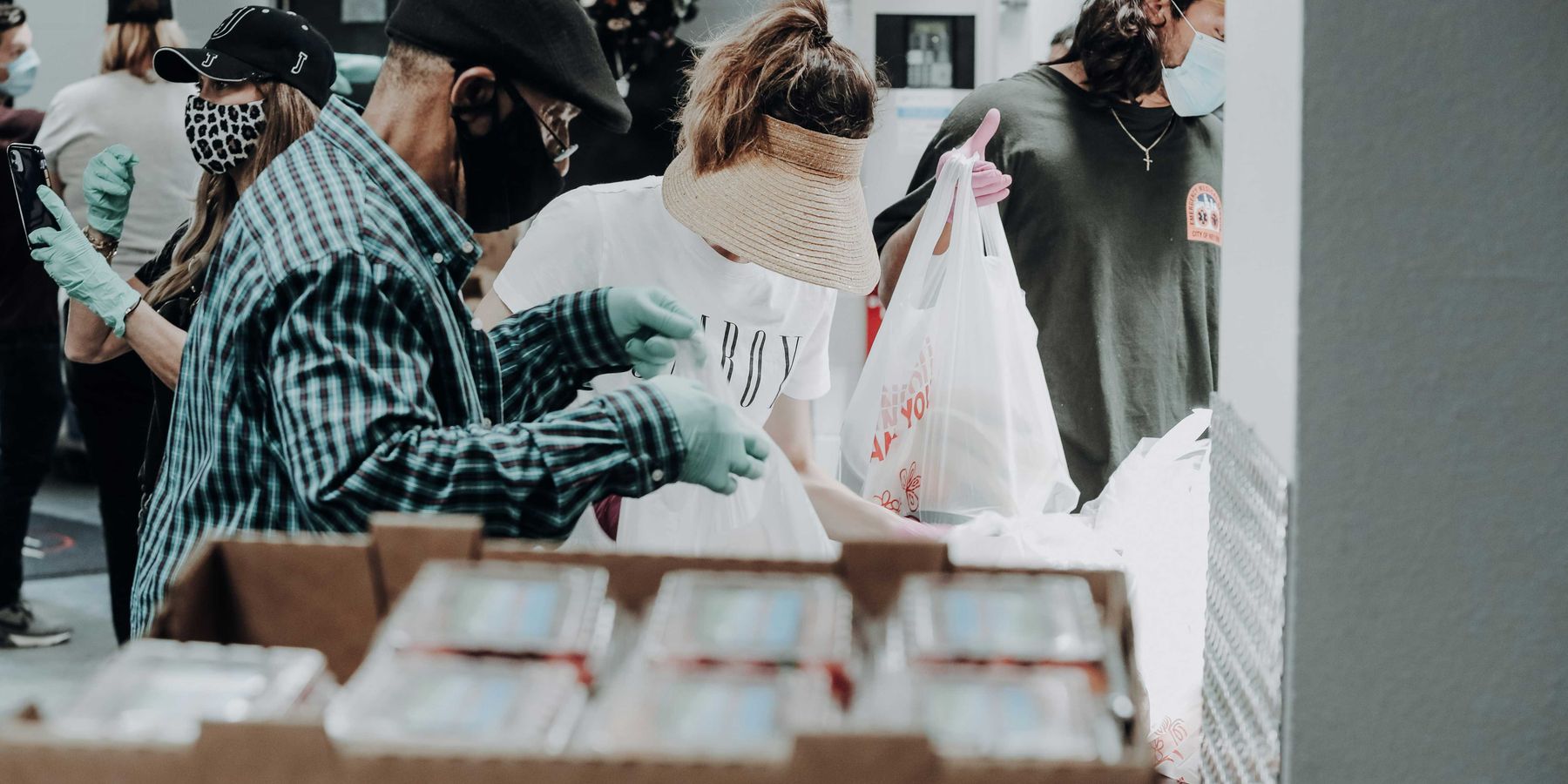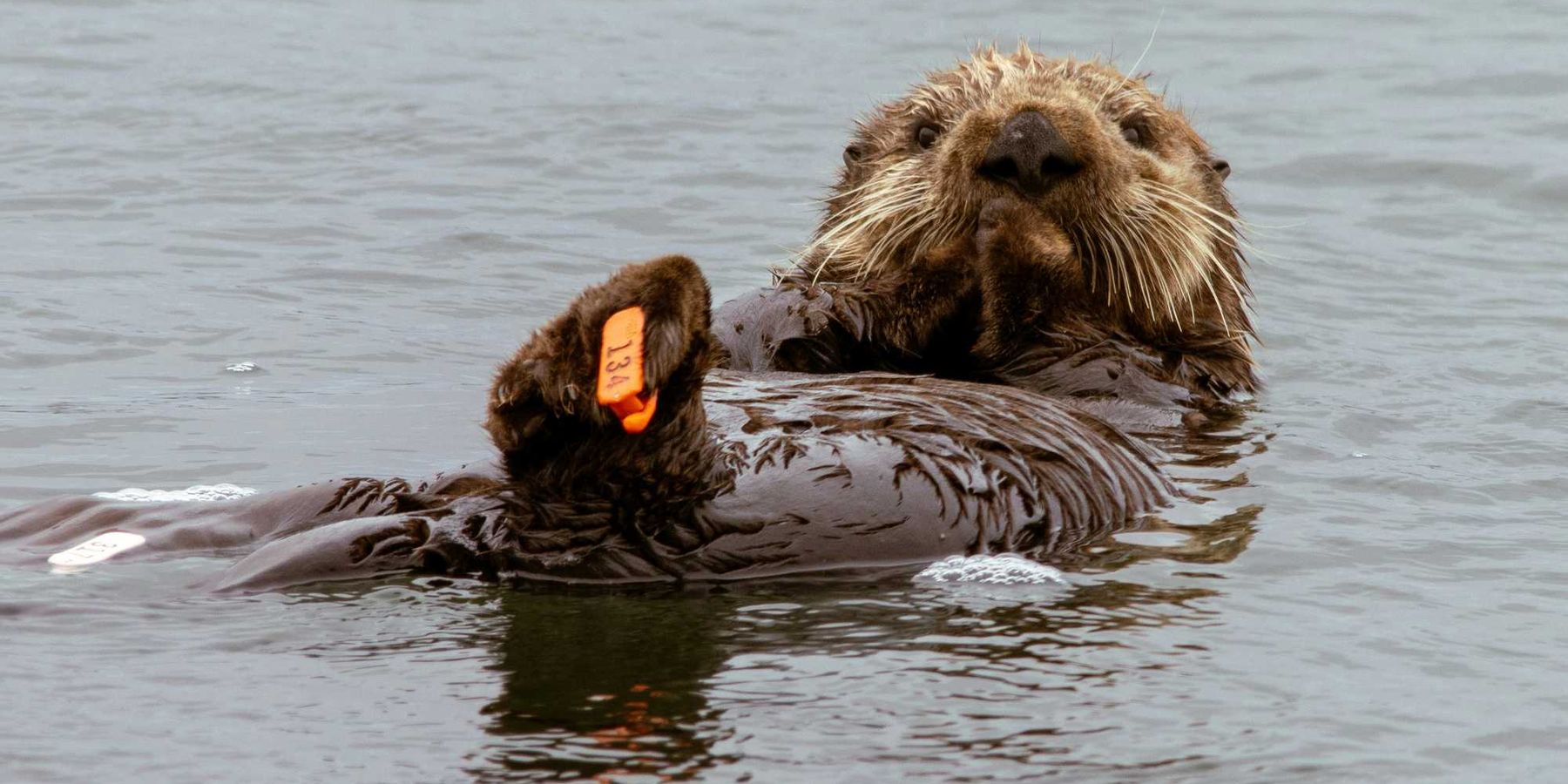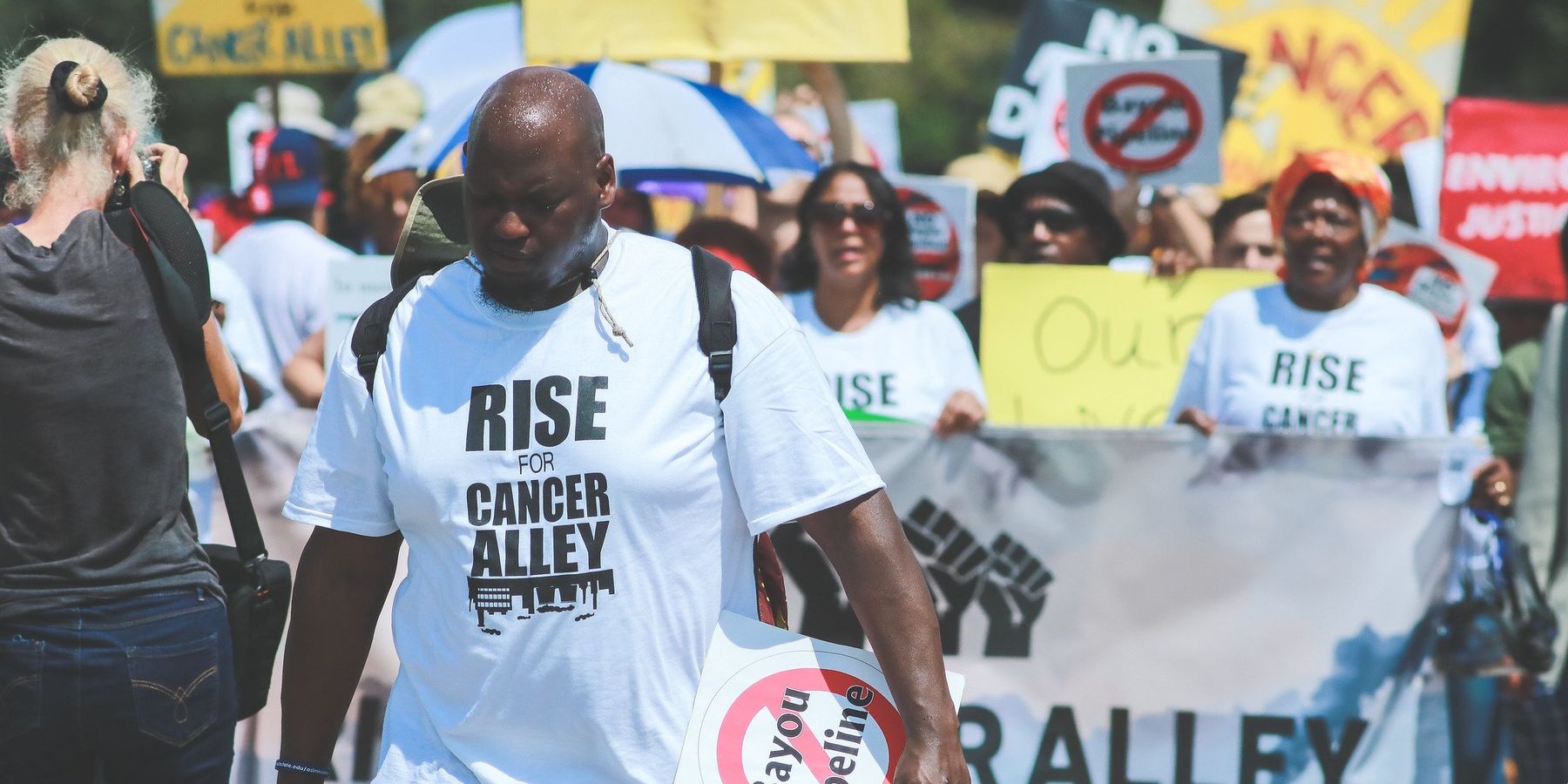
Op-ed: “I’m sorry, I can’t hear you” — disabling environments in Cancer Alley and the Ohio River Valley
For communities plagued by energy extraction and petrochemical buildout, struggles of environmental justice often fall on deaf ears.
The low hum of a tour bus engine underpins the constant buzzing of insects. Air conditioning on full blast circulates the bus interior, shielding us from the muggy Louisiana summer.
Sharon Lavigne stands at its center, microphone in hand. She crouches slightly, one hand gripping the headrest of a black leather seat, and peeks out the tinted windows. White petroleum storage tanks stand in stark contrast to the green grass and red bricked homes. A man mows his lawn, his toddler rolling down the sidewalk in a Cozy Coupe.
To read a version of this story in Spanish click here. Haz clic aquí para leer este reportaje en español.
Ms. Lavigne shares tidbits of the health-related ailments of the residents of St. James Parish, a fragmented conglomerate of homes, elongated fields and petrochemical infrastructure. She points to a house, “he died of a rare cancer last year.” She points to another, “her daughter decided to leave after she became gravely ill.”
Whispers fill the cabin, muffled by disposable masks. I struggle not only to hear, but to truly comprehend the myriad ways in which the predominantly African-American community has been disabled, robbed of its full potential by the petrochemical industry.
Hearing, seeing and being in the world has always been different for me. At a young age, it was found that I had Single Sided Deafness (SSD) – or unilateral hearing loss – meaning that I could not hear out of my right ear at all. Living with SSD has brought me a heightened spatial awareness, allowing for a more introspective understanding into the complexities of the environment. My experience has led me to believe that analyzing environmental injustices through a disability lens can help us to better understand communities – how humans and the environment are inextricably linked and how my own feelings of isolation in contexts that ignore my disability mirror how the struggles of environmental justice often fall on deaf ears. Understanding disabilities forces us to look at who is excluded, what barriers perpetuate that exclusion and what assumptions are made about the interactions between people and the places they live in. I believe the same questions can be asked to better capture the lives of environmental justice communities burdened by the oil and gas industry.
While geographically distant, Cancer Alley, where St. James Parish is located, and the Ohio River Valley, where I’ve spent most of my time as a geographer, share common challenges. Both have been utilized as sacrifice zones for energy extraction, and, in many ways, have been disabled. They have also been socially barred by the broader U.S., cast off as rural, backwards and seemingly unoccupied spaces that are not worth “saving.” This reality reminds me of the many ways in which meeting the needs of people with disabilities is considered a "burden" that is not worth attending to as a society.
And yet, both people with disabilities and these two regions have continued to exist, to persevere and to fight back against injustice. Like my hearing disability, just because someone – or an entire community or region – is disabled (or assumed to be), does not mean that they are not able.
A disabling context
Growing up with a physical disability was no small feat. I had trouble locating sounds, constantly felt a dull, ringing sensation and was unable to wear traditional hearing aids. I received ridicule from classmates, poking fun at my inability to hear adequately on my right-side. At times I felt defeated, unable to cope with the mentally debilitating prospect of being labeled “different.” And yet, over time and into adulthood, I have grown to accept and understand my hearing disability, as it has shaped me into the person that I am today.
Living with Single Sided Deafness, I occupy an in-between space. In some contexts, I am considered disabled, while in others I might appear able to the naked eye. This perception of disability – both my own and others’ – shifts over time and in different contexts. The environments we occupy can also be an in-between space where factors outside of our immediate control can shift the way we act and exist in the world. I often think about communities in Cancer Alley as also occupying an in-between space, as they’ve been cast away as a “sacrifice zone” but at the same time they’re creating real progress. People like Ms. Lavigne embody the community’s struggle between the harm inflicted and the progress being made toward justice. In March, her organization Rise St. James, among other environmental advocacy groups, filed an application to ask the Louisiana Supreme Court to grant review and overturn the issuance of Formosa Plastics’ air permits. Further, Rise St. James has urgently called on President Biden to stop Formosa from building their a mega petrochemical facility in St. James Parish, which has gained traction toward the White House.
Living with Single Sided Deafness, I occupy an in-between space.
On that bus ride, I positioned myself close to Ms. Lavigne to fully understand her words. Ms. Lavigne is the leader of Rise St. James, a faith-based community organization that works to stop the proliferation of petrochemical industries in St. James Parish, Louisiana. Adorned in her Rise St. James tee, Ms. Lavigne spoke at-length of the Parish’s history. Starting in the 1980s, fossil fuel, oil-refining and plastic-production operations have proliferated along an 85-mile stretch on the Mississippi River between New Orleans and Baton Rouge, running directly through the Parish. Such facilities emit high levels of harmful air pollutants and other environmental toxics, which have caused a high incidence of rare cancers, respiratory diseases, asthma and other severe health conditions. Today, the area is known as Cancer Alley.
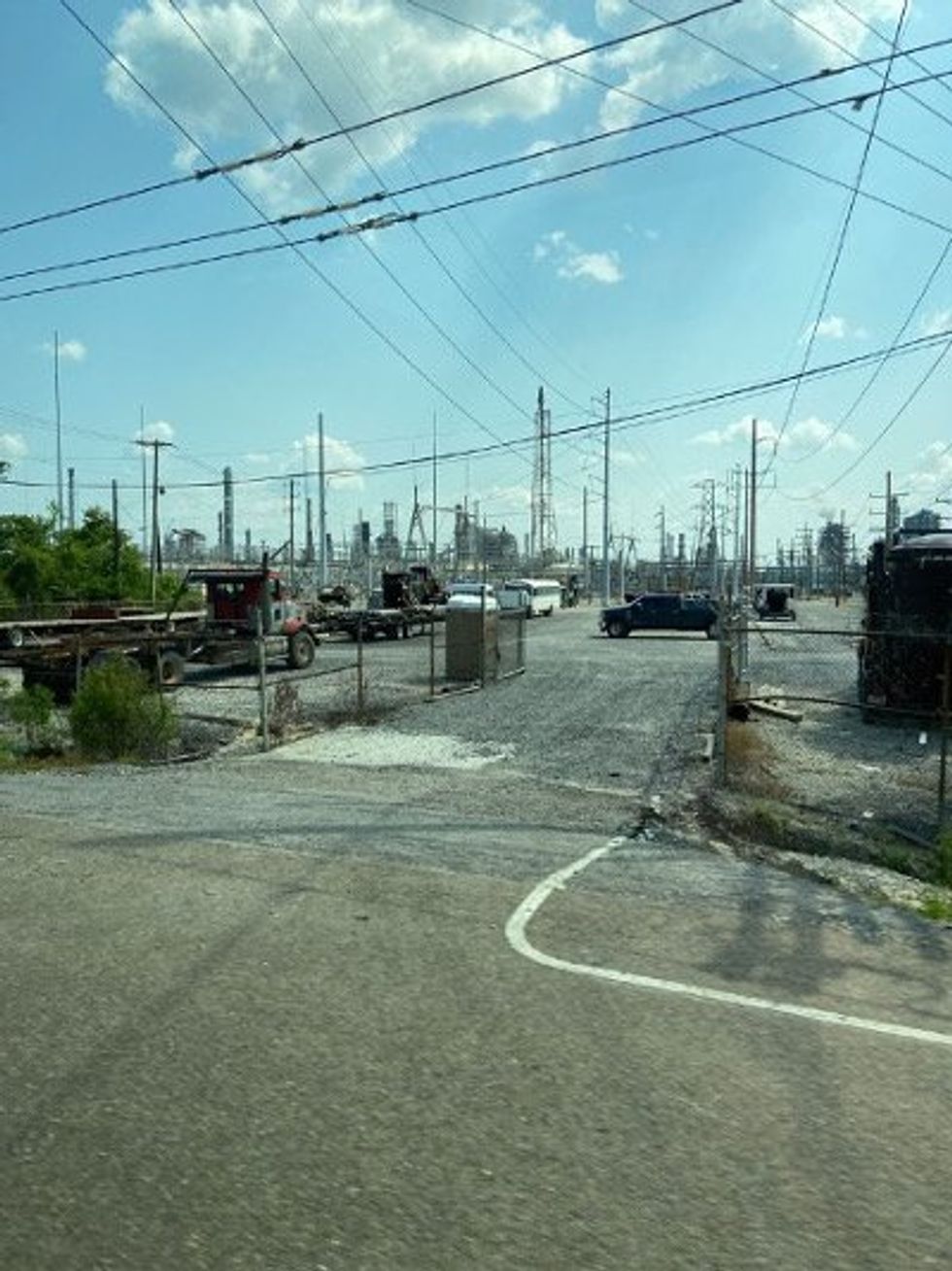
Shell Norco Manufacturing Complex outside of New Orleans, Louisiana.
Credit: Brandon Rothrock
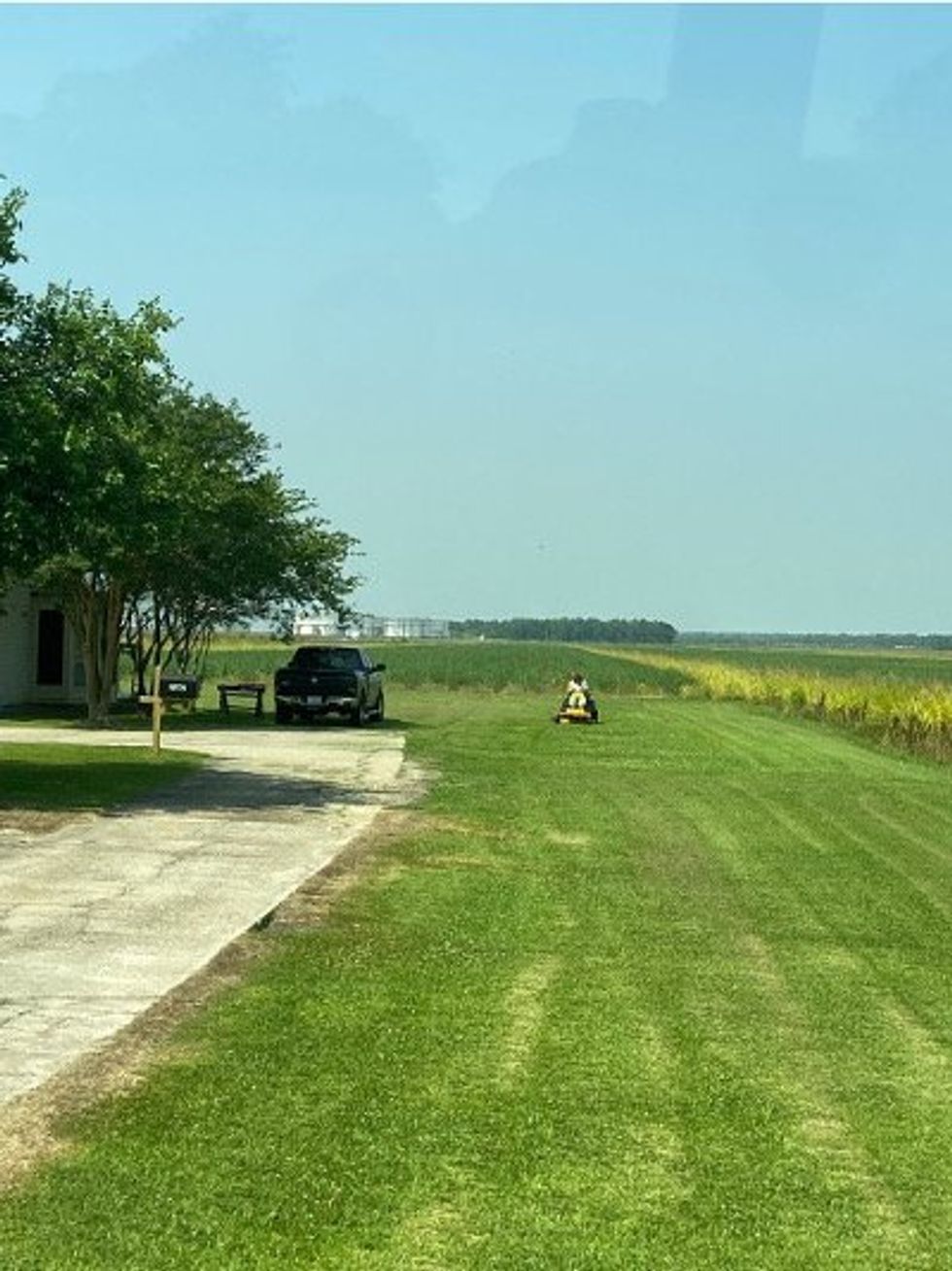
A man mowing the lawn outside his house in St. James Parish, Louisiana.
Credit: Brandon Rothrock
Despite the obvious injustices these communities already face, Louisiana state officials continue to downplay environmental and health concerns raised by Rise St. James. The most recent example is their support for a proposed $9.4 billion petrochemical complex called the Sunshine Project, heralded by Formosa Petrochemical Corporation. The proposed complex would include 14 facilities that will process ethane from fracked natural gas to produce various chemicals used in everyday materials such as single-use plastics and antifreeze. In the “name of progress,” the majority African American community is forced to exist in a disabling environment: a context that makes them incapable of breathing clean air and living long and healthy lives. This situation in Louisiana reflects a broader national issue.
Despite the obvious injustices these communities already face, Louisiana state officials continue to downplay environmental and health concerns raised by Rise St. James.
Fracked natural gas – the kind of gas the Sunshine Project would process– is in itself another example of how this industry disables communities, and there’s no better example than the Ohio River Valley. For centuries, communities in Pennsylvania, Ohio and West Virginia, first through coal and now through natural gas, have been dominated by fossil fuels production. In the last two decades, the region, which sits on top of the largest shale gas formation in the U.S., has become the epicenter of the country’s fracking industry. Injecting chemicals deep underground to fracture shale deposits and release the gas stored within them releases climate warming gasses like methane, and airborne toxics like particulate matter, which are linked to respiratory problems and other health conditions like skin issues and cancer. It also pollutes underground water supplies with cancer-causing chemicals like PFAS, also known as “forever chemicals.”
Fracking continuously fractures communities. The physical landscape is altered forever while people grapple with a shattered sense of community, damaged property and high rates of depression. Here again, we see communities being robbed of their ability and barred from their agency. Such extractive acts can be considered disabling, in the sense that once communities lose their ability to exist and make decisions freely, the industry will be able to extract further. In a similar vein to Rise St. James, Appalachian-based groups such as the Ohio River Valley Institute work directly with community partners to fight back against injustice.Fighting back against injustice
I often find myself struggling in large lecture halls where the acoustics are poor, and the professor’s voice is drowned out. I also miss critical pieces of the lectures due to a lack of closed captions or visual aids, such as lecture slide printouts. Similarly, friends who may be visually impaired frequently encounter poorly designed websites that can make accessing course materials impossible. All of this creates a hostile environment for people with disabilities to thrive – just like communities are faced with a harsh environment that disables them from reaching their full potential.
I fear this disabling context will only become more entrenched in both regions. As fracking continues to balloon across the Appalachian region, so do petrochemical facilities: at least 61 are in construction or in operation across the Ohio River Valley. The outlook for Cancer Alley communities is no better: in 2015, the Environmental Integrity Project documented 44 petrochemical construction and expansion projects proposed or permitted, with a majority cited for Louisiana. On top of this, the U.S. Department of Energy selected the Ohio River Valley and the Gulf Coast as two of the seven proposed Regional Clean Hydrogen Hubs, which are a national network of “clean” hydrogen producers. Touted by politicians as an advancement toward energy independence, these regional hydrogen hubs will fill the landscape with pipelines, fueling stations and carbon storage facilities, locking-in the regions to further plastic production and energy infrastructure buildout for decades to come.
I worry that this build out will further entrench disadvantaged communities in a cycle of destruction. Rhetoric such as “sacrifice zone,” “backwards” and other related terms used to describe Appalachia and Cancer Alley are deeply entrenched in the national psyche, further perpetuating assumptions about the people who live there. But having been there, I think reframing communities facing environmental injustices is needed.
My visit to St. James Parish revealed something profound: the beauty, uniqueness and resilience of these communities. On that bus ride with Sharon Lavigne, I saw children playing joyfully against the backdrop of towering industrial complexes. As we stopped and ate lunch at a community center, I saw community members laughing and chatting about their days, organizing for a better future. Ms. Lavigne’s words – and those of the community – resonated deeply as they spoke of their battle against injustice and the determination to fight for what is right. Her dedication and the community’s solidarity in the face of adversity illustrated remarkable strength.
Environmental justice communities deserve a future where their resilience is not tested by pollution but celebrated and supported by just and equitable practices. As future leaders and educators, it is our responsibility to better understand how extractive practices can disable and to work towards fostering environments that enable and uplift.
This essay was produced through the Agents of Change in Environmental Justice fellowship, a partnership between Environmental Health News and Columbia University's Mailman School of Public Health. Agents of Change empowers emerging leaders from historically excluded backgrounds in science and academia to reimagine solutions for a just and healthy planet.


